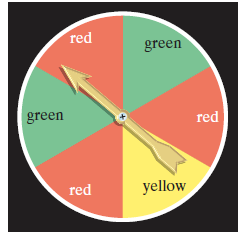
Concept explainers
Exercises 1-26 involve probabilities with independent events.
Use the spinner shown to solve Exercises 1-10. It is equally probable that the pointer will land on any one of the six regions. If the pointer lands on a borderline, spin again. If the pointer is spun twice, find the probability it will land on

If the pointer is spun three times, find the probability it will land on
green and then red and then yellow.
Want to see the full answer?
Check out a sample textbook solution
Chapter 11 Solutions
MyLab Math with Pearson eText -- Access Card -- for Thinking Mathematically
Additional Math Textbook Solutions
Elementary Statistics (13th Edition)
Finite Mathematics for Business, Economics, Life Sciences and Social Sciences
Pathways To Math Literacy (looseleaf)
College Algebra Essentials (5th Edition)
Elementary Statistics: Picturing the World (7th Edition)
Elementary & Intermediate Algebra
- Equilibrium Equations: Two-dimensional 2.28 Ra= Rc= 2.29 (change force to 600N) AC= AB= 2.33 CD= AC= DE= BC= Free Body Diagrams 2.34 Ax= Ay=_ Bx= By= 2.36 Ax= Ay= Bx= By= 2.37 (change middle force to 4000 lbs) Ay=_ Dx= Dy=_ 2.38 (change horizontal force to 2 kN) Ax= Ay= Bx= By=_ 2.40 Ay= By= Dx= 32% Bx= Cy= Dy=arrow_forwardYou can add the two forces together to get the total force at each joint.arrow_forwardFor 2.29 Find the forces in AC and CB (not AB) that are pushing on the joint C. Please also include an arrow that shows how the forces are pushing on joint C. Are they pushing on C or pulling on C. For 2.29 change force to 600N.arrow_forward
- 1. Let n be an integer. Show that gcd (n², n² + n + 1) = 1. Note: You must justify every step of your proof using a result shown either in this course or in a previous one. Steps without a proper justification will not account for credit. 2. Express the following in base 10. Show all the necessary work to obtain your answer. (a) 12345 (b) 101012 (c) 11111 3. a) Convert the base 10 number 54321 to base 6. Show all the necessary work to obtain your answer. b) Convert the base 10 number 100 to base 2. Show all the necessary work to obtain your answer. 4. 6. For each of the following equations, find all integral solutions or show that it has none. Show all the necessary work to obtain your answer. (a) 3x+4y=10 (b) 44x-17y = 9 (c) 60x+9y= 31 (d) 16x + 24y = 44 5. What is the smallest nonzero value of X Y - where x and y are integers? Show all the necessary 136 31 work to obtain your answer. 6. Find the prime factorization of the following integers. Show all the necessary work to obtain your…arrow_forwardEquilibrium Equations: Two-dimensional 2.28 Ra= Rc= 2.29 (change force to 600N) AC= AB= 2.33 CD= AC= DE= BC= Free Body Diagrams 2.34 Ax= Ay=_ Bx= By= 2.36 Ax= Ay= Bx= By= 2.37 (change middle force to 4000 lbs) Ay=_ Dx= Dy=_ 2.38 (change horizontal force to 2 kN) Ax= Ay= Bx= By=_ 2.40 Ay= By= Dx= 32% Bx= Cy= Dy=arrow_forwardThe expression (w.wx+8) represents the number of miles Trent jogged during a race, and 5x represents the number of miles that Ling jogged during the same race, in x hours. Write and simplified expression to show how many more miles Ling jogged than Trentarrow_forward
- Firm Alpha operates in a perfectly competitive market in a constant-cost industry and is earning negative economic profit. a. How does Firm Alpha determine its profit-maximizing quantity of output? Explain. b. Draw correctly labeled side-by-side graphs for Firm Alpha and the market it operates in. Label the axes and all of the following: i. Market price (PE) and market quantity (QE) ii. The firm's quantity of output (Qe) iii. The firm's average total cost (ATC) c. Completely shade the area of the firm's total cost. d. Identify whether the following increase, decrease, or remain constant as the market moves to long-run equilibrium: i. Market equilibrium quantity ii. Market equilibrium price e. Assume the product that Firm Alpha produces has a negative externality. Draw the marginal social cost (MSC) on the market graph from part (b). f. Will the unregulated market produce more or less than the socially optimal quantity? g. Label the socially optimal quantity (Qso) for the market on your…arrow_forwardGoods A, B, and C are related goods, each operating in a perfectly competitive market. a. As the price of Good A increases from $8 to $10, its quantity demanded falls from 200 units to 160 units. Calculate the price elasticity of demand for this range. b. Good A is an input for Good B. Illustrate the effect of the price change from part (a) on a fully labeled supply and demand graph for Good B. Label the equilibrium price(s) and quantity or quantities. Use arrows to indicate any shifts. c. On your graph from (b), shade the consumer surplus lost in the market for Good B as a result of the change in part (a). d. The equilibrium price for Good C is $2, and the equilibrium quantity is 60 units. The cross-price elasticity of Good C with Good A is -3. i. Are Good C and Good A normal goods, inferior goods, complementary goods, or substitute goods? ii. Calculate the new equilibrium quantity of Good C after a 25% price increase for Good A.arrow_forwardLet a = (-4, 5, 4) and 6 = (1,0, -1). Find the angle between the vector 1) The exact angle is cos 2) The approximation in radians isarrow_forward
- The only problems I need help with ae the last 8 ones, Thanksarrow_forwardPrice (S) The graph below depicts a firm with market power. In the graph, MC represents the firm's marginal costs, ATC represents the average total costs, D represents demand, and MR represents marginal revenue. 110 70 60 50 40 30 20 MC ATC D 0 40 50 70 80 95 Quantity/Units MR a. At 60 units of output, how much would this profit-maximizing monopolist charge? b. How many units would it produce to maximize total revenue rather than total profit? c. What is the maximum quantity this firm can produce without incurring economic losses? d. Calculate the firm's profit at the profit-maximizing output and price. e. Why is this firm's marginal revenue curve below its demand curve? Explain.arrow_forwardA well-known company predominantly makes flat pack furniture for students. Variability with the automated machinery means the wood components are cut with a standard deviation in length of 0.45 mm. After they are cut the components are measured. If their length is more than 1.2 mm from the required length, the components are rejected. a) Calculate the percentage of components that get rejected. b) In a manufacturing run of 1000 units, how many are expected to be rejected? c) The company wishes to install more accurate equipment in order to reduce the rejection rate by one-half, using the same ±1.2mm rejection criterion. Calculate the maximum acceptable standard deviation of the new process.arrow_forward
 College Algebra (MindTap Course List)AlgebraISBN:9781305652231Author:R. David Gustafson, Jeff HughesPublisher:Cengage Learning
College Algebra (MindTap Course List)AlgebraISBN:9781305652231Author:R. David Gustafson, Jeff HughesPublisher:Cengage Learning Holt Mcdougal Larson Pre-algebra: Student Edition...AlgebraISBN:9780547587776Author:HOLT MCDOUGALPublisher:HOLT MCDOUGAL
Holt Mcdougal Larson Pre-algebra: Student Edition...AlgebraISBN:9780547587776Author:HOLT MCDOUGALPublisher:HOLT MCDOUGAL
- Algebra & Trigonometry with Analytic GeometryAlgebraISBN:9781133382119Author:SwokowskiPublisher:Cengage



